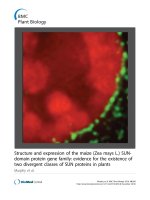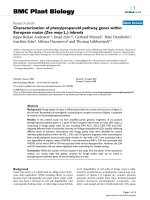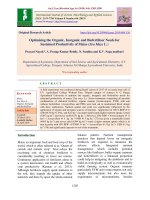Variability analysis for various quantitative traits in maize (Zea mays L.) Hybrids
Bạn đang xem bản rút gọn của tài liệu. Xem và tải ngay bản đầy đủ của tài liệu tại đây (138.11 KB, 4 trang )
Int.J.Curr.Microbiol.App.Sci (2019) 8(9): 365-368
International Journal of Current Microbiology and Applied Sciences
ISSN: 2319-7706 Volume 8 Number 09 (2019)
Journal homepage:
Original Research Article
/>
Variability Analysis for Various Quantitative Traits
in Maize (Zea mays L.) Hybrids
B. Manjunatha*, B. Niranjana Kumara, H.G. Sannathimmappa and A.M. Maruthesha
Agricultural and Horticultural Research Station, Kathalagere
University of Agricultural and Horticultural Sciences, Shivamogga-577219, India
*Corresponding author
ABSTRACT
Keywords
Heritability,
Variability,
Pollen, Silking
Article Info
Accepted:
04 August 2019
Available Online:
10 September 2019
The experiment was conducted at Agricultural and Horticultural Research Station, Kathal
agere during kharif 2018. Estimation of variability parameters like environmental
variability, Genotypic variability, Genotypic coefficient of variability, Phenotypic
variability, Phenotypic Coefficient of Variability, Heritability (h2), Genetic advancement at
5%, Genetic advancement as % of mean 5% and General mean. In the present study
twenty seven diverse hybrids were grown in RCBD design with three replications during
Kharif 2018 to study the genetic parameters viz. ANOVA, GCV, PCV, h2 and Genetic
Advance (GA). The results indicates that ANOVA for all the characters viz. cob weight,
shelling %, moisture %, initial plants and, final plant stand, cob count, days to 50% pollen
shed, days to 50% silking, days to70% dry husk, plant height, ear height are highly
significant while grain yield showed significant values. The high GCV and PCV values
were observed for grain yield, cob weight while moderate GCV and PCV values were
shown by moisture %, days to 70% dry husk and cob count. High heritability coupled with
high expected genetic advance in percent of mean was observed for grain yield, cob count,
days to 70% dry husk, plant height and ear height. Conclusively PCV was higher GCV
indicates that environmental role in the expression of these traits.
Introduction
Maize (Zea mays L.) is the third most
important cereal crop after rice and wheat.
Maize has myriad of uses in food, feed and
industrial segment. Globally 67 per cent of
maize is used for livestock feed, 25 per cent
for human consumption, 14% for starch
products, 1% each for beverages and seed and
rest for industrial purposes. Genetic EEC 2015 - 278 variability is of greatest interest to
the plant breeder as it plays a vital role in
framing successful breeding programme.
Heritability of a metric character is a
parameter of particular significance as it
measures the degree of resemblance between
the parents and off-springs. The knowledge of
heritability enables the plant breeder to decide
the course of selection procedure to be
followed under a given situation (Li and Yang,
1985). Genetic advance aids in exercising the
necessary selection pressure. Keeping in view
365
Int.J.Curr.Microbiol.App.Sci (2019) 8(9): 365-368
the importance of these aspects a study was
conducted to know variability, heritability and
genetic advance in twenty seven in breds of
maize which will help to ascertain the real
potential value of the genotypes.
Materials and Methods
The experimental materials consisted of
twenty seven inbred lines of maize obtained
from All India Coordinated maize research
centre, Regional station, Hyderabad. Twenty
seven genotypes were sown during kharif,
2018 in Randomized Block Design with three
replications. Each entry was sown as four
rows of 4 meter length with row-to-row and
plant-to-plant distance of 75cm and 30cm
respectively. All the agronomic practices
along with prophylactic plant protection
measures were followed so as to raise a good
crop. Observations were recorded on five
randomly selected plants for Plant height
(cm), Plant stand, Moisture (Per cent), Ear
height(Cm), Cob Weight. (Kg), Number of
Cobs. However, observations for the
characters namely days to 50 per cent
tasseling, days to 50percent silking, days to
maturity were recorded on plot basis. Analysis
of variance was computed based on
Randomized Block Design for each of the
character separately as per standard statistical
procedure given by (Panse and Sukhatme,
1978). Heritability (h²) in the broad sense was
calculated according to the formula given by
(Allard, 1960) for all characters. Phenotypic
and genotypic coefficients of variation (PCV
and GCV) were computed according
to(Burton,1952). For statistical analysis,
Windostat Version 9.1 software package was
used.
Results and Discussion
Analysis of variance for the experiment
involving a set of 27 hybrid lines of maize for
six quantitative traits revealed highly
significant mean sum of squares for all the
characters indicating greater diversity among
the genotypes. The results of significant mean
sum of squares due to genotypes for all the
traits studied were reported by (Manjunatha et
al., 2018, Rafiq et al., 2010; Reddy et al.,
2013; Nagabhushan et al., 2011; Suresh et al.,
2012). The results pertaining to genetic
parameters viz., phenotypic coefficient of
variation (PCV), genotypic coefficient of
variation (GCV), broad sense heritability (h)
and genetic advance as percent of
mean(GAM) for all the six characters are
furnished in Table 1. The Highest magnitude
of both PCV (12.87%) and GCV (42.5%)
were observed forcob weight followed by ear
height (4.3%- 12.63%) suggesting that these
characters were under the influence of genetic
control. Similar reports were earlier given by
(Akbar et al., 2008; Reddy et al., 2013) for
cob weight and ear height. The characters
plant height (9.3%-7.33%), plant stand (3.5%7.08)were recorded for moderate magnitudes
of both PCV and GCV, respectively. Similar
results were reported by (Krishnam Raju,
2001) for days to 50% tasseling indicating the
predominance of non-additive gene action.
The phenotypic coefficient of variation was
higher than genotypic coefficient of variation
(GCV) for all the characters under study but
the GCV was greater than the variation
produced by the environment for all the
characters. The results are in agreement with
the findings of (Srivas and Singh, 2004;
Abirami et al., 2005; Mustafa et al., 2014).
Heritability estimates were high for all the
traits under study except cob weight which
recorded moderate estimate of heritability.
This suggested the greater effectiveness of
selection and improvement to be expected for
these characters in future breeding programme
as the genetic variance is mostly due to the
additive gene action. The results are in
consonance with the reports given by (Natraj
et al., 2014) for cob weight, ear height, plant
height.
366
Int.J.Curr.Microbiol.App.Sci (2019) 8(9): 365-368
Table.1 Variability parameters for various quantitative traits of maize inbreeds
Variability parameters
Environmental variability
Genotypic variability
GCV
Phenotypic variability
PCV
Heritability
Genetic advancement
@5%
Genetic advancement as %
of mean 5%
General mean
Plant
Plant Moisture
height(cm) stand
(Per
cent)
383.23
16.5
0.87
6.11
5.34
0.138
0.93
3.5
2.055
377.12
21.8
0.73
7.33
7.08
4.74
42.00
44.00
48.00
0.65
2.35
0.33
Ear
height
(Cm)
164.6
22.23
4.36
186.9
12.63
61.00
3.35
Cob
Weight
(Kg)
53953.9
49.51
12.87
54003.4
425.15
51.00
0.439
Cobs
(Number)
16.53
5.35
3.50
21.88
7.08
25.00
2.35
0.24
3.56
1.83
4.3
0.562
4.57
264.9
66.06
18.07
108.23
54.66
66.06
Higher genetic advance was found for plant
height (65.00%) followed by ear height
(61.86%),plant height (6.5 %), cob weight
(43.9%), number of cobs per plant (23.5%)
and plant stand (23.5%). Similar results for
high genetic advance for grain yield per plant
were earlier reported by (Arun Kumar Singh
et al. 2018; Suresh et al., 2012; Kanagarasu et
al., 2013; Bekele et al., 2014).
High
heritability coupled with high genetic advance
was observed for grain yield per plant, ear
height and plant height and ear length. It
indicates the role of additive gene action in
controlling the traits; hence pedigree method
of breeding will be a rewarding one to
improve the traits under investigation. Similar
results were reported by (Kabdal et al., 2003)
for grain yield, plant height, ear height and
ear length. For grain yield per plant and
number of kernelsper row (Hepziba et al.,
2013).
height, plant height, number of kernels per
row, 100 – seed weight and ear length
Indicate the role of additive gene action in
controlling the traits, hence pedigree method
of breeding will be a rewarding one to
improve the traits under investigation.
References
Abirami, S., Vanniarajan, C. and Armugachamy,
S. 2005. Genetic variability studies in
maize (Zea mays L.) germplasm. Plant
Archives. 5 (1): 105-108.
Akbar, M., Shakoor, S., Hussain, A. and Sarwar,
M. 2008.Evaluation of maize 3-way crosses
through genetic variability, broad sense
heritability, characters association and path
analysis. Journal of Agricultural Research.
46 (1): 39-45.
Allard, R.W. 1960. Principles of Plant Breeding.
John Wiley and Sons Inc., New York, USA.
pp. 485.
Arun Kumar Singh, S.P. Mishra and Roshan
Parihar. 2018, Studies on Genetic
Variability Parameters on Grain Yield and
Its Yield Attributing Traits in Maize (Zea
mays L.), Int.J.Curr.Microbiol.App.Sci,
7(9): 1261-1266
Bekele, T. A. and Rao, N. 2014. Estimates of
heritability, genetic advance and correlation
In conclusion, high estimates of PCV and
GCV were recorded for grain yield per plant
and ear height which provides considerable
variability and offers scope for genetic
improvement through selection. Further high
heritability coupled with high genetic advance
were observed for grain yield per plant, ear
367
Int.J.Curr.Microbiol.App.Sci (2019) 8(9): 365-368
study for yield and it’s attributes in maize
(Zea Mays L.). Journal of Plant Sciences. 2
(1): 1-4.
Burton, G.W. 1952. Quantitative inheritance in
grasses. Proceedings of sixth International
Grassland Congress. 1: 227-281.
Hepziba, S.J., Geetha, K. and Ibrahim, S.M. 2013.
Evaluation of genetic diversity, variability,
character association and path analysis in
diverse inbreds of maize (Zea mays L.).
Electronic Journal of Plant Breeding. 4(1):
1067-1072.
Kabdal, M.K., Verma, S.S., Ahmad, N. and
Panwar, U.B.S. 2003. Genetic variability
and correlation studies of yield and its
attributing characters in maize (Zea mays
L.). Agricultural Science Digest. 23 (2):
137-139.
Kanagarasu, S., Nallathambi, G., Kannan, S. and
Ganesan, K.N. 2013. Genetic variability
and association analysis for yield and its
components in single cross hybrids of
maize (Zea mays L.). Electronic Journal of
Plant Breeding.4 (4): 1319-1324.
Krishnam Raju, K. 2001. Variability studies for
protein content and grain yield in maize
(Zea mays L.) genotypes. M. Sc. Thesis,
Acharya N. G. Ranga Agricultural
University, Rajendranagar, Hyderabad.
Li, C.M. and Yang, K.C. 1985. Studies on
inheritance of quantitative characters for
plant type in some inbred lines of maize.
Scientia Agriculture Sinical. 9: 28-36.
Manjunatha. B, Niranjana Kumara. B and G.B.
Jagadeesh, 2019. Performance Evaluation
of Maize Hybrids (Zea mays L.).
Int.J.Curr.Microbiol.App.Sci (2018) 7(11):
1198-1203.
Mustafa, H.S.B., Aslam, M., Hasan, E., Hussain,
F. and Farooq, J. 2014. Genetic variability
and path coefficient in maize (Zea mays L.)
genotypes. The Journal of Agricultural
Sciences. 9: 37-43.
Nagabhushan, N.M., Chandrashekhar, H.,
Shashibhaskar, M.S. and Prahalada, G.D.
2011. Genetic variability and correlation
studies for yield and related characters in
single cross hybrids of maize (Zea mays
L.). Current Biotica. 5(2): 157-163.
Nataraj, V., Shah, J.P. and Vandana, D. 2014.
Estimates of variability, heritability and
genetic advance in certain inbreeds of
maize (Zea mays L.).International Journal
of Applied Biology and Pharmaceutical
Biology. 5(1): 205-208.
Panse, V.G. and Sukhatme, P.V. 1978. Statistical
methods for Agricultural workers. Indian
Council
of
Agricultural
Research
Publications, New Delhi. 235-246.
Rafiq, M., Rafique, M., Hussain, A. and Altaf, M.
2010. Studies on heritability, correlation
and path analysis in maize (Zea mays L.).
Journal of Agricultural Research. 48 (1):
35-38.
Reddy, V.R., Jabeen, F., Sudarshan, M.R. and
Rao, A.S.2013. Studies on genetic
variability, heritability, correlation and path
analysis in maize (Zea mays L.) over
locations. International Journal of Applied
Biology and Pharmaceutical Technology. 4
(1): 195-199.
Srivas, S.K. and Singh, U.P. 2004. Genetic
variability, character association and path
analysis of yield and its component traits in
forage maize (Zea mays L.). Range
Management and Agro forestry. 25(2): 149153.
Suresh, H., Sasidharan, N., Chakraborty, S., Patel,
J.N., Trivedi, R., Panwar, B.S. and Ashish
Vala. 2012. Genetic analysis and character
association studies for yield and different
phenotypic characters in maize (Zea mays
L.) International Journal of Plant Sciences.
7 (2): 341-350.
How to cite this article:
Manjunatha, B., B. Niranjana Kumara, H.G. Sannathimmappa and Maruthesha, A.M. 2019.
Variability Analysis for Various Quantitative Traits in Maize (Zea mays L.) Hybrids.
Int.J.Curr.Microbiol.App.Sci. 8(09): 365-368. doi: />
368









